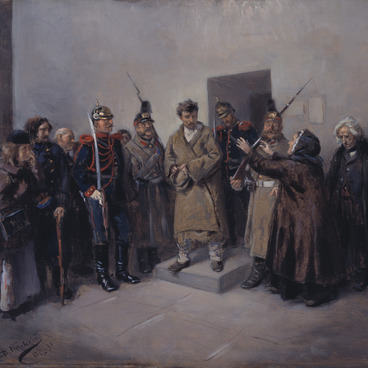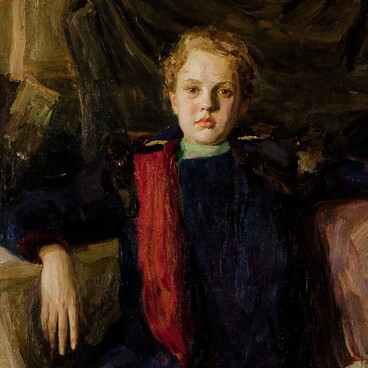The portrait of an unknown naval officer appeared in the collection of the Volgograd Museum in 1980 when Nina Arning-Zaitseva donated it to the museum. She inherited the collection of her husband, Kazimir Arning, who was a famous Moscow lawyer and collector.
The portrait belongs to the genre of parsuna, which is a type of the early Russian secular portrait. Parsuna comprises peculiar features of icon-painting — static and flat figure and exaggerated volume of face depiction. As a rule, the face was painted from life unlike the rest of the figure.
When the work was donated to the museum, it was denoted as a portrait of Admiral Fyodor Ushakov, which was doubted by experts.
The character of the painting is depicted wearing the captain uniform of the Catherine II era. There are the Order of St. George of fourth class and the Order of St. Vladimir of fourth class with the bows in the buttonholes. The inscription ‘Chesma’ is on epaulets meaning participation of the officer in the Russo-Turkish War of 1768–1774. However, Ushakov did not take part in the Battle of Chesma.
There is a pennon in blue, red, and white colors — the pennon of the Baltic Fleet; that is the evidence according to which the experts have considered the depicted naval port located in the Baltic Sea. A three-master is placed behind the officer; there are St. Andrew’s ensign in the stern and three more flags —St. Andrew’s flag and two pennons — on the mast.
Over the years, various researchers have attempted to identify the personality of the portrait character. First, fine art experts supposed that Alexander Cruz — a participant of the Battle of Chesma and Russian admiral of Danish origin — is depicted in the painting.
Cruz was awarded the Order of St. George of the fourth class; however, there is no information about his second award — the Order of St. Vladimir of the fourth class. Moreover, in 1779, Cruz was awarded the title of Rare Admiral, while the Order of St. Vladimir would be established three years later, which meant that Cruz could not be depicted in the portrait wearing the Capitan uniform and having the Order of St. Vladimir.
After restoration and paint layer cleaning, the inscription read: ‘S[hip] J[ohn] the BAP[tist]: the CHESMA ALSO’. The Baltic Fleet ship had a double name — the Chesma and John the Baptist. After looking through the lists of the Chesma crew, the researchers chose two officers, which may have been the portrait characters.
The first one was James Perston, an Englishman and a participant of the Battle of Chesma, the Battle of Chios, and others. Preston was the ship captain during Paul I reign.
The second possible person depicted in the painting was Robert Gall, the captain-commander (the title lower than the rear admiral, but higher than the captain), who served on the Chesma during Alexander I reign. The emperor did not allow officers to have wigs with curls above their ears and long wigs plaits, which should have been shortened by half. The portrait character has the exact type of wig.
The portrait belongs to the genre of parsuna, which is a type of the early Russian secular portrait. Parsuna comprises peculiar features of icon-painting — static and flat figure and exaggerated volume of face depiction. As a rule, the face was painted from life unlike the rest of the figure.
When the work was donated to the museum, it was denoted as a portrait of Admiral Fyodor Ushakov, which was doubted by experts.
The character of the painting is depicted wearing the captain uniform of the Catherine II era. There are the Order of St. George of fourth class and the Order of St. Vladimir of fourth class with the bows in the buttonholes. The inscription ‘Chesma’ is on epaulets meaning participation of the officer in the Russo-Turkish War of 1768–1774. However, Ushakov did not take part in the Battle of Chesma.
There is a pennon in blue, red, and white colors — the pennon of the Baltic Fleet; that is the evidence according to which the experts have considered the depicted naval port located in the Baltic Sea. A three-master is placed behind the officer; there are St. Andrew’s ensign in the stern and three more flags —St. Andrew’s flag and two pennons — on the mast.
Over the years, various researchers have attempted to identify the personality of the portrait character. First, fine art experts supposed that Alexander Cruz — a participant of the Battle of Chesma and Russian admiral of Danish origin — is depicted in the painting.
Cruz was awarded the Order of St. George of the fourth class; however, there is no information about his second award — the Order of St. Vladimir of the fourth class. Moreover, in 1779, Cruz was awarded the title of Rare Admiral, while the Order of St. Vladimir would be established three years later, which meant that Cruz could not be depicted in the portrait wearing the Capitan uniform and having the Order of St. Vladimir.
After restoration and paint layer cleaning, the inscription read: ‘S[hip] J[ohn] the BAP[tist]: the CHESMA ALSO’. The Baltic Fleet ship had a double name — the Chesma and John the Baptist. After looking through the lists of the Chesma crew, the researchers chose two officers, which may have been the portrait characters.
The first one was James Perston, an Englishman and a participant of the Battle of Chesma, the Battle of Chios, and others. Preston was the ship captain during Paul I reign.
The second possible person depicted in the painting was Robert Gall, the captain-commander (the title lower than the rear admiral, but higher than the captain), who served on the Chesma during Alexander I reign. The emperor did not allow officers to have wigs with curls above their ears and long wigs plaits, which should have been shortened by half. The portrait character has the exact type of wig.


